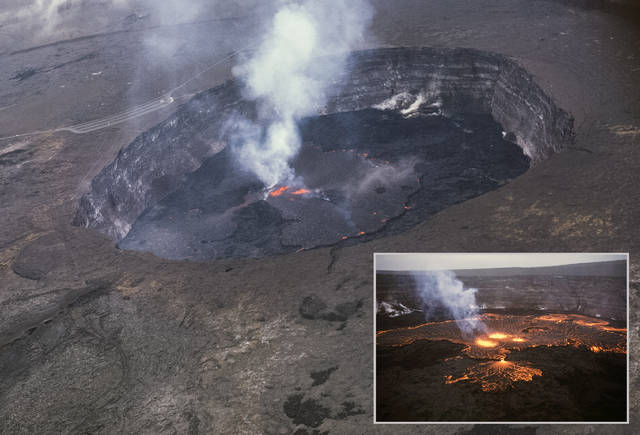Editor’s note: Due to space limitations, Volcano Watch was left out of Sunday’s print edition so it is being published today. It will return to Sunday’s Home section next week.
HAWAII NATIONAL PARK — To set the stage for next week’s Volcano Watch about the upcoming anniversary of Kilauea Volcano’s current summit eruption, this week we revisit the history of past Halemaumau eruptions.
We do so by reprising parts of a Volcano Watch article written in December 2008, soon after the ongoing Halemaumau lava lake reached a milestone as Kilauea’s longest summit eruption since 1924.
That year is used as a frame of reference for Halemaumau eruptions, because 1924 ended a 100-plus-year period of nearly continuous lava lake activity at the summit of Kilauea.
Historically, a summit eruption has been the “normal” for Kilauea Volcano. However, in the 19th and early 20th centuries, Halemaumau looked much different than it does today. It was an irregular landscape of craggy spires and islands with as many as six transient lava lakes.
But in May 1924, the long-lived lava lake that existed in Halemaumau drained away, resulting in explosive eruptions that doubled the diameter of the crater to about 3,000 feet. Afterward, Halemaumau looked much the way we see it now, except that it was almost five times deeper than it is today.
Since then, Halemaumau has erupted 18 times. The first was in July 1924, when an 11-day eruption formed a small pool of lava on the crater floor.
Over the next 10 years, six eruptions — in 1927, 1929 (two), 1930, 1931, and 1934 — took place within Halemaumau. They varied in duration from two to 33 days, but each eruption added a layer of molten rock to the crater floor. With thicknesses averaging about 60 feet, these layers reduced the depth of Halemaumau to about 800 feet.
The end of the 1934 summit eruption marked the beginning of Kilauea’s longest period of quiet on record. For nearly 18 years, there were no eruptions anywhere on the volcano.
Kilauea made up for lost time when molten lava returned to Halemaumau in June 1952. That spectacular eruption went on for 136 days, with lava fountains sometimes visible above the crater rim. By the time it ended, the eruption had filled the crater with more than 390 feet of new lava.
Over the next 30 years, Halemaumau erupted nine times — in 1954, 1961 (three), 1967, 1968, 1971, 1974, 1975, and 1982. These eruptions varied greatly in duration, from about 7 hours (1975) to 251 days (1967-1968, the second longest summit eruption since 1924).
Today, the floor of Halemaumau is about 280 feet below the crater rim. Most of the rock covering the crater floor was emplaced during the 1974 eruption, which lasted less than a day.
The 1974 lava fountains, up to 330 feet high, initially erupted on the northeast rim of Halemaumau, and then migrated as a fissure across the crater floor and up the west crater wall. Molten lava quickly engulfed the entire crater floor, except for the tops of three high spatter cones created during the 1967-1968 eruption.
In April 1982, a fissure that opened on the caldera floor northeast of Halemaumau erupted low lava fountains for 19 hours. Lava flows spread north and south of the erupting fissure and into Halemaumau, covering about 76 acres, including a “puddle” of lava on the floor of the crater.
Each Halemaumau eruption between 1924 and March 2008, when the current summit eruption began, has its own unique story. Most of them, however, describe activity strikingly similar to what we are now experiencing — emissions of sulfur dioxide gas, ash-rich plumes, and poor air quality — but only a few produced a lake of lava like the one that exists today.
Kilauea Volcano’s ongoing summit eruption reaches its 10th anniversary on March 19.
Highlights from the decade-long eruption will be featured in next week’s Volcano Watch. The history of the eruption and lava lake within Halemaumau is also presented in a 24-minute video that can be freely viewed on the USGS YouTube channel.
Is a summit eruption and Halemaumau lava lake once again the “normal” for Kilauea? The story is still unfolding, so stay tuned — and visit the USGS Hawaiian Volcano Observatory website for the latest information, photos and videos.
Volcano Activity Updates
This past week, Kilauea Volcano’s summit lava lake level fluctuated with summit inflation and deflation, ranging about 75–128 feet below the vent rim. On the East Rift Zone, the 61g lava flow remained active downslope of Puu Oo, with scattered breakouts on the pali and coastal plain, but no ocean entry. The 61g flows do not pose an immediate threat to nearby communities.
Mauna Loa is not erupting. Only a few small-magnitude earthquakes occurred beneath the volcano, primarily at depths shallower than 8 miles. Most notable were two earthquakes with magnitudes of 3.1 and 3.0 on Mauna Loa’s upper southwest rift on March 3 and 4, respectively. GPS and InSAR measurements continue to show slow deformation related to inflation of a magma reservoir beneath the summit and upper Southwest Rift Zone. Rates of inflation in the past few months have decreased compared to rates of the past year. It is uncertain if these lower rates will persist or pick up again in the near future. No significant changes in volcanic gas emissions were measured.
No earthquakes were reported felt in the Hawaiian Islands this past week.
Volcano Watch is a weekly article and activity update written by U.S. Geological Survey Hawaiian Volcano Observatory scientists and affiliates.
Please visit HVO’s website (https://volcanoes.usgs.gov/hvo) for past Volcano Watch articles, Kilauea daily eruption updates, Mauna Loa weekly updates, volcano photos, maps, recent earthquake info, and more. Call for summary updates at 967-8862 (Kilauea) or 967-8866 (Mauna Loa). Email questions to askHVO@usgs.gov.



